Related Research Articles
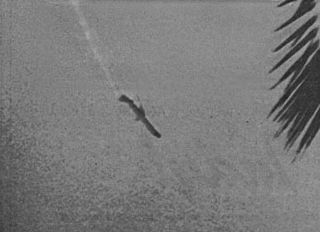
Aeroméxico Flight 498 was a scheduled commercial flight from Mexico City, Mexico, to Los Angeles, California, United States, with several intermediate stops. On Sunday, August 31, 1986, the McDonnell Douglas DC-9 operating the flight was clipped in the tail section by N4891F, a Piper PA-28-181 Cherokee owned by the Kramer family, and crashed into the Los Angeles suburb of Cerritos, killing all 64 on the DC-9, all three on the Piper and an additional 15 people on the ground. Eight on the ground also sustained minor injuries. Blame was assessed equally on the Federal Aviation Administration (FAA) and the pilot of the Cherokee. No fault was found with the DC-9 or the actions of its crew.

On 12 November 1996, Saudia Flight 763, a Boeing 747 en route from Delhi, India, to Dhahran, Saudi Arabia, and Kazakhstan Airlines Flight 1907, an Ilyushin Il-76 en route from Chimkent, Kazakhstan, to Delhi, collided over the city of Charkhi Dadri, around 100 km west of Delhi. The crash killed all 349 people on board both planes, making it the world's deadliest mid-air collision and the deadliest aviation accident ever in India. The crash was caused by failure of the Kazakh crew to maintain the correct altitude, because of confused dialogue with the tower communicated via the radio operator. In addition, departures and arrivals both shared a single corridor within the civilian airspace around New Delhi.

On December 16, 1960, a United Airlines Douglas DC-8 bound for Idlewild Airport in New York City collided in midair with a TWA Lockheed L-1049 Super Constellation descending toward LaGuardia Airport. The Constellation crashed on Miller Field in Staten Island and the DC-8 in Park Slope, Brooklyn, killing all 128 aboard the two aircraft and six people on the ground. The accident was the world's deadliest aviation disaster at the time, and remains the deadliest accident in the history of United Airlines.
Grand Canyon Airlines is a 14 CFR Part 135 air carrier headquartered on the grounds of Boulder City Municipal Airport in Boulder City, Nevada, United States. It also has bases at Grand Canyon National Park Airport and Page Municipal Airport, both in Arizona. It operates sightseeing tours and charter service over and around the Grand Canyon. Its headquarters and main operation center is Grand Canyon National Park Airport and Boulder City Municipal Airport. The company slogan is With Grand Canyon Airlines, Your Memories are Cleared for Takeoff!

All Nippon Airways (ANA) Flight 58 was a Japanese domestic flight from Chitose Airport to Haneda Airport, operated by All Nippon Airways (ANA). On 30 July 1971, at 02:04 local time, a Japan Air Self-Defense Force (JASDF) F-86F Sabre jet fighter collided with the Boeing 727 airliner operating the flight, causing both aircraft to crash. All 162 people aboard the airliner were killed, while the Sabre pilot, a trainee with the JASDF, freed himself from his airplane after the collision and parachuted to safety. This incident led to the resignation of both the head of Japan's Defense Agency and the JASDF chief of staff.
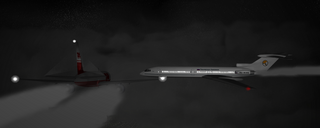
In aviation, a mid-air collision is an accident in which two or more aircraft come into unplanned contact during flight. Owing to the relatively high velocities involved and the likelihood of subsequent impact with the ground or sea, very severe damage or the total destruction of at least one of the aircraft usually results.
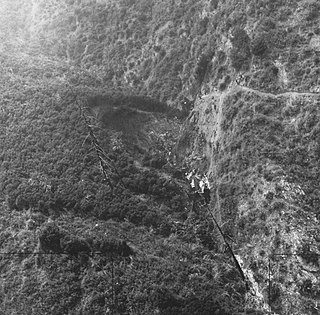
Hughes Airwest Flight 706 was a regularly scheduled flight operated by American domestic airline Hughes Airwest from Los Angeles, California to Seattle, Washington, with several intermediate stops. On Sunday, June 6, 1971, the McDonnell Douglas DC-9 serving as Flight 706 departed Los Angeles just after 6 p.m. en route to Seattle as a McDonnell Douglas F-4 Phantom II of the United States Marine Corps was approaching Marine Corps Air Station El Toro near Irvine at the end of a flight from Naval Air Station Fallon in Nevada. The two aircraft collided in midair over the San Gabriel Mountains near Duarte, killing all 49 aboard the DC-9 and the F-4 pilot; the F-4 radar intercept officer ejected and survived.

Northeast Alabama Regional Airport is five miles southwest of Gadsden, in Etowah County, Alabama. It is owned by Gadsden Airport Authority and it used to be Gadsden Municipal Airport. The FAA's National Plan of Integrated Airport Systems for 2009–2013 categorized as a general aviation facility.
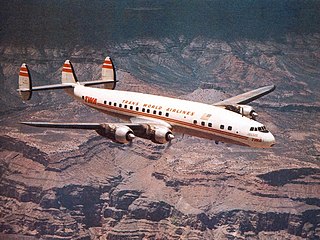
The Grand Canyon mid-air collision occurred in the western United States on June 30, 1956, when a United Airlines Douglas DC-7 struck a Trans World Airlines Lockheed L-1049 Super Constellation over Grand Canyon National Park, Arizona. The first plane fell into the canyon while the other slammed into a rock face. All 128 on board both airplanes perished, making it the first commercial airline incident to exceed one hundred fatalities. The airplanes had departed Los Angeles International Airport minutes apart from each other and headed for Chicago and Kansas City, respectively. The collision took place in uncontrolled airspace, where it was the pilots' responsibility to maintain separation. This highlighted the antiquated state of air traffic control, which became the focus of major aviation reforms.

As of July 2020, a total of 60 Boeing 747 aircraft, or just under 4% of the total number of 747s built, first flown commercially in 1970, have been involved in accidents and incidents resulting in a hull loss, meaning that the aircraft was either destroyed or damaged beyond economical repair. Of the 60 Boeing 747 aircraft losses, 32 resulted in no loss of life; in one, a hostage was murdered; and in one, a terrorist died. Some of the aircraft that were declared damaged beyond economical repair were older 747s that sustained relatively minor damage. Had these planes been newer, repairing them might have been economically viable, although with the 747's increasing obsolescence, this is becoming less common. Some 747s have been involved in accidents resulting in the highest death toll of any civil aviation accident, the highest death toll of any single airplane accident, and the highest death toll of a midair collision. As with most airliner accidents, the root of cause(s) in these incidents involved a confluence of multiple factors that rarely could be ascribed to flaws with the 747's design or its flying characteristics.

The 1948 Gatow air disaster was a mid-air collision in the airspace above Berlin, Germany that occurred on 5 April, sparking an international incident. A British European Airways (BEA) Vickers VC.1B Viking airliner crashed near RAF Gatow air base, after being struck by a Soviet Air Force Yakovlev Yak-3 fighter aircraft. All ten passengers and four crew on board the Viking were killed, as was the Soviet pilot. The disaster resulted in a diplomatic standoff between the United Kingdom and United States on one hand, and the Soviet Union on the other, and intensified distrust leading up to the Berlin Blockade in the early years of the Cold War.

The Federal Aviation Act of 1958 was an act of the United States Congress, signed by President Dwight D. Eisenhower, that created the Federal Aviation Agency and abolished its predecessor, the Civil Aeronautics Administration (CAA). The act empowered the FAA to oversee and regulate safety in the airline industry and the use of American airspace by both military aircraft and civilian aircraft.

United Air Lines Flight 736 was a scheduled transcontinental passenger service flown daily by United Airlines between Los Angeles and New York City. On April 21, 1958, the airliner assigned to the flight, a Douglas DC-7 with 47 on board, was flying over Clark County, Nevada in clear weather when it was involved in a daytime mid-air collision with a United States Air Force fighter jet crewed by two pilots. Both aircraft fell out of control from 21,000 feet (6,400 m) and crashed into unpopulated desert terrain southwest of Las Vegas, leaving no survivors. The loss of Flight 736, one of a series of 1950s mid-air collisions involving passenger aircraft in American skies, helped usher-in widespread improvements in air traffic control within the United States, and led to a sweeping reorganization of federal government aviation authorities.

The 1948 Northwood mid-air collision took place on 4 July at 15:03 when a Douglas DC-6 of Scandinavian Airlines System (SAS) and an Avro York C.1 of the Royal Air Force (RAF) collided in mid-air over Northwood in London, UK. All thirty-nine people aboard both aircraft were killed. It was SAS's first fatal aviation accident and was at the time the deadliest civilian aviation accident in the UK. It is still the deadliest mid-air collision in British history.

The Grand Canyon mid-air collision occurred when Grand Canyon Airlines Flight 6, a de Havilland Canada DHC-6 Twin Otter, collided with a Bell 206 helicopter, Helitech Flight 2, over Grand Canyon National Park on June 18, 1986. All 25 passengers and crew on board the two aircraft were killed. It remains the deadliest accident involving a helicopter on United States soil, surpassing the crash of Los Angeles Airways Flight 841 in 1968, which killed 23 people.
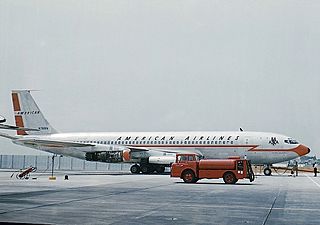
American Airlines Flight 1502 was a crew training flight from Idlewild International Airport. On January 28, 1961, the Boeing 707 operating the flight crashed out of control into the Atlantic Ocean 9.5 miles (15.3 km) west of Montauk Point, New York, and all six crew on board were killed. The cause of the crash was never officially determined. Flight 1502 would be the second of three 707s that American lost in a three-year period in the New York area.
Ground collision (GCOL), also known as terrain collision refers to the collision that occurs while an aircraft is taxiing to or from its runway. A ground collision occurs when an aircraft collides with another aircraft and/or structure on the runway.
References
- ↑ "Midair Collision Report – General Aviation Joint Safety Committee". www.gajsc.org. Retrieved 2024-01-18.
- ↑ "Mid-Air Collision | SKYbrary Aviation Safety". skybrary.aero. Retrieved 2024-01-18.
- ↑ turner, t (2022-09-21). "Mid-Air Strategies". Aviation Safety. Retrieved 2024-01-18.
- ↑ "Two Commercial Planes Crashed in Midair in 1922—a Tragic First". HistoryNet.com. Retrieved 2024-01-18.
- ↑ Ryan, Oswald; Branch, Harllee; Lee, Josh; Board, Clarence M. Young for the Civil Aeronautics. Aviation Accident Report: Eastern Air Lines Flight 45 (Revised) - Wikisource, the free online library . Retrieved 2024-01-18.
{{cite book}}:|website=ignored (help) - ↑ "1948 Gatow air disaster in Berlin, Germany". Virtual Globetrotting. 2014-01-10. Retrieved 2024-01-19.
- ↑ "London's Forgotten Disasters: Collision Over Northwood". Londonist. 2013-07-04. Retrieved 2024-01-18.
- ↑ "Mid-air collision Accident Avro Anson T Mk 21 VV243". aviation-safety.net. Retrieved 2024-01-18.
- ↑ "ASN Aircraft accident Douglas C-54B-10-DO (DC-4) N88727 Washington-National Airport, DC (DCA)". aviation-safety.net. Retrieved 2024-01-18.
This article needs additional or more specific categories .(January 2024) |